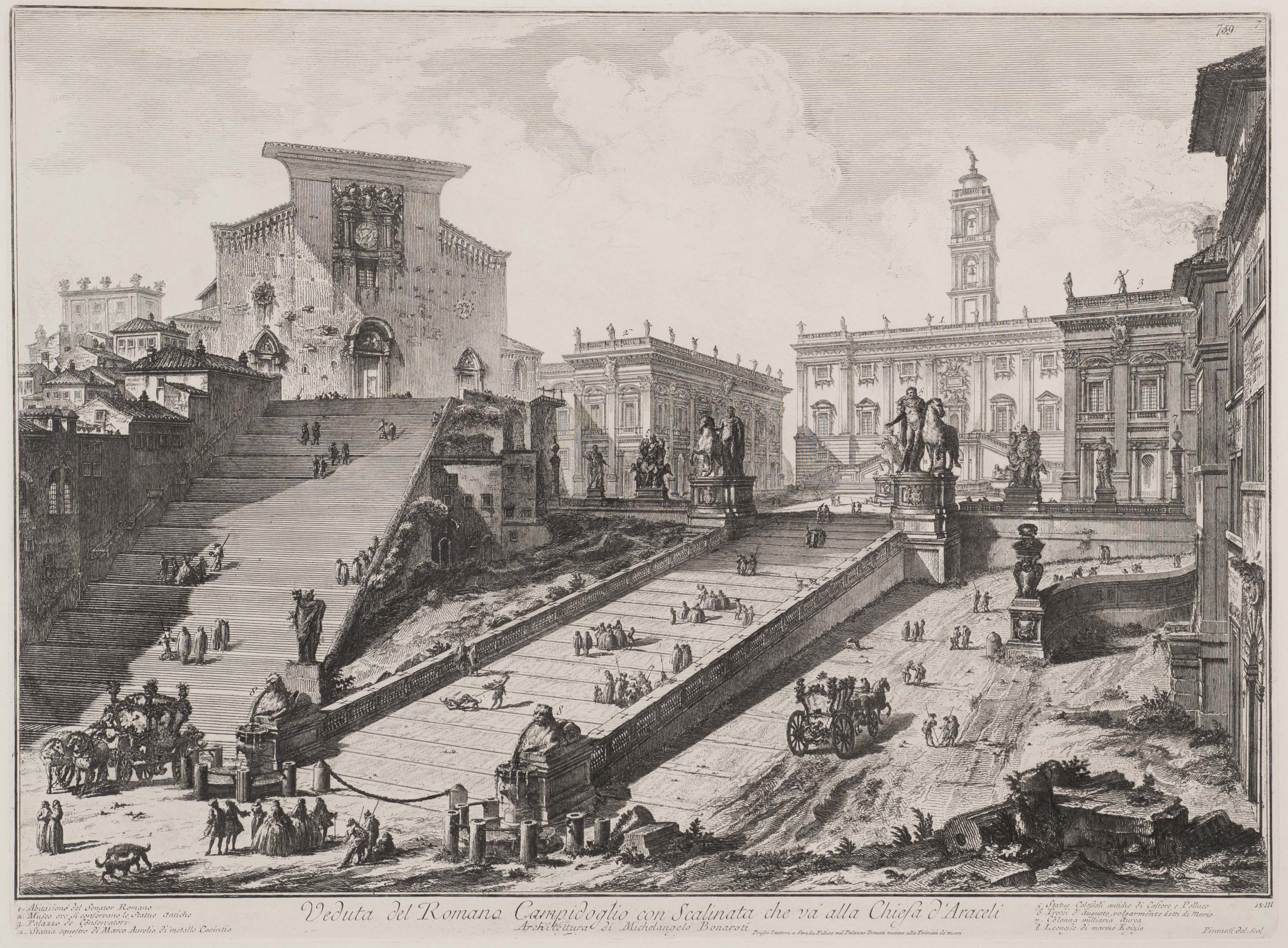Capitoline Hill
View of the Capitoline hill with the steps leading to the church of Santa Maria in Aracoeli (Veduta del Romano Campidoglio con scalinata che va alle Chiesa d'Araceli), from the series “Views of Rome,” c. 1750, etching on wove paper, Sheet/Page 21 7/8 H x 28 W in. Gift from the Trustees of the Corcoran Gallery of Art (Bequest of Frank B. Bristow), GW Collection (CGA.68.26.837)
By Nikolas Diakolios with contributions by Aoran Zhang
Many of Piranesi’s vedute focus on ancient Roman architecture; however, the main subjects of View of the Capitoline hill with the steps leading to the church of Santa Maria in Aracoeli are the Renaissance style Piazza del Campidoglio and the Medieval Basilica of Santa Maria in Aracoeli. In the center of the Piazza del Campidoglio, the plaza topping the hill, is the Palazzo Senatorio, the seat of the city’s municipality. Flanking the Palazzo Senatorio are the Palazzo Nuovo and Palazzo dei Conservatori on the left and right respectively. This print embodies the qualities of a capriccio, a work of architectural fantasy, that Piranesi utilizes to create a sense of grandeur and fantasy in his other works. He exaggerates elements of the architecture to make the structures more impressive and chooses a point of perspective that adds to this effect. The viewer looks down on the figures on the ground and slightly up at the structures. By doing this Piranesi creates a sense of inequality. Juxtaposing the rather small figures, even the horses seem insignificant with the monumental edifices on the hill. Although his choice of perspective conveys a sense of grandeur on its own, the height of the Patarina Tower on the Palazzo Senatorio is exaggerated as another way to add to the grandeur. The tower is made taller and stands against the cloudy sky like a lone beacon.
Similarly, Piranesi uses chiaroscuro, a technique involving the contrasting of light and dark elements, to draw attention to specific points. The statues of Castor and Pollux at the top of the balustrades stand out against the grand architecture of the Piazza del Campidoglio due to the dark shadows cast by their dynamic poses and the lighter shade of the structures in the background. This portrayal creates a convincing illusion of depth that helps the viewer envision the Palazzo Senatorio further behind the statues and emphasizes the size of the piazza behind them. Furthermore, the deep shadows cast by the balustrades and the steps emphasize the importance of the piazza and basilica by drawing the viewer’s eyes along above the horizon, ending at the base of the basilica and entry of the piazza.
Piranesi mildly departs from his focus on the architecture of antiquity to depict the medieval facade of the Basilica of Santa Maria and the Renaissance renovation to the Piazza del Campidoglio done by Michelangelo in the sixteenth century. Although the Capitoline Hill held great religious and civic importance to the ancient Romans, no ancient Roman architecture is visible today from this particular view. At one time, the Capitoline Hill had been the location of the Temple of Jupiter Optimus Maximus, a significant religious site to the ancient denizens of Rome. Nails that were annually driven into the walls of the inner chamber of the Temple of Jupiter Optimus Maximus date its dedication to approximately 509 BCE. Although the temple was destroyed and rebuilt a number of times, an incarnation of it was in use until pagan worship was outlawed by Theodosius I in 392 CE. The classical legacy that can be gleaned from this scene remains only in the statues that adorn the piazza: the statues of Castor and Pollux, the Equestrian statue of Marcus Aurelius, and the Trophies of Augustus, among others. Piranesi’s depiction of the Capitoline Hill appears not to be an attempt to aggrandize ancient Rome – but rather to celebrate the long and persistent history of the city.
Although Piranesi often highlights the decay of the monumental structures of Rome in many of his other works, in this work he chooses to highlight the ancient, medieval, and renaissance elements present on the Capitoline Hill. Through his use of contrast and perspective, Piranesi draws the viewer's attention to monuments and architecture that reflect the wide variety of styles in Rome. In this way, Piranesi puts forward the Capitoline Hill as a display of the rich artistic tradition in Italy.
Inscription in Italian
a. Architettura di Michelangelo Bonaroti
i. Presio l’Autore a Strada Felice nel Palazzo Tornati vicino alla Trinità dei Monti
1. Abitazione del Senator Romano
2. Musco ove Si Conservano le’ Statue Antiche
3. Palazzo de Conservatori
4. Statua Equestre di Marco Aurelio di’ Metallo Corintio
5. Statue Colossali Antiche di Castore e Polluce
6. Trofei d’Augusto Volgarmente Detti di Mario
7. Colonna Miliaria Aurea
8. Leonesse di Marmo Egizio
English Translation by Andrew Gibson:
a. Architecture by Michelangelo Bonaroti
i. From the author’s (home), at Strada Felice nel Palazzo Tornati near the Trinità dei Monti
1.Home of the Roman Senator
2. Museum for the conservation of ancient statues
3. Palace of the conservatory
4. Equestrian Statue of Marcus Aurelius in Corinthian metal
5. Ancient colossal statues of Castor and Pollux
6. Trophies of Augustus, often called trophies of Mario
7. The Golden Milestone column
8. Lioness of Egyptian marble
View on Google Maps.
Bibliography
Bringmann, Klaus. “Foundation of the city of Rome” chapter in A History of The Roman Republic translated by W. J. Smyth. Polity Press, 2007.


